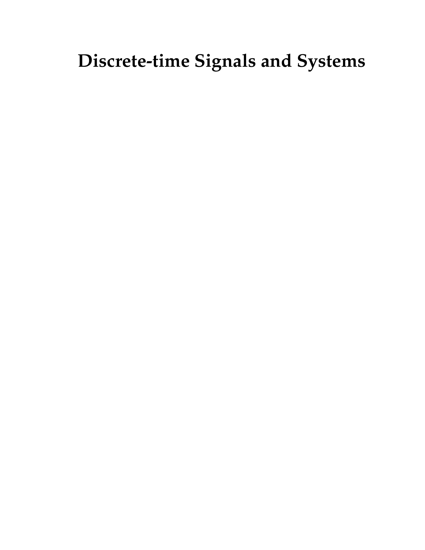Discrete-time Signals and Systems - An Operator Approach

简介:
本书旨在向您介绍分析和设计系统的强大工具-无论是电子,机械还是热。这本书源于 “信号和系统” 课程 (编号为6.003),我们已经教了麻省理工学院的电气工程和计算机科学的学生。
传统的信号和系统课程-例如 [17] -强调连续时间系统的分析,特别是模拟电路。然而,大多数工程师不会专注于模拟电路。相反,数字技术提供了如此巨大的计算能力,以至于模拟电路通常是通过数字仿真来设计的。
数字仿真是固有的离散时间操作。此外,信号和系统的几乎所有基本思想都可以使用离散时间系统来教授。例如,模块化和多重表示有助于离散时间 (或连续时间) 系统的设计。同样,模式、极点、控制和反馈的想法。
此外,通过在不限于电路的上下文中教授材料,我们强调了这些工具的通用性。在自然和工程世界中,反馈和模拟比比皆是,我们希望我们的学生在理解和设计这些系统时具有灵活性和创造性。因此,我们从离散时间系统开始我们的 “信号与系统” 课程,并给我们的学生这本书。与大多数离散时间系统讨论的根本区别在于使用运算符的方法。运算符可以避免 “转换” 的混乱概念。相反,离散时间系统的运算符表达式和系统的脉冲响应是同一系统的两个表示形式; 它们是从两个不同的坐标系看到的点的坐标。然后,系统的转换具有积极的意义: 例如,将两个系统组合起来以构建一个新系统。
英文简介:
This book aims to introduce you to a powerful tool for analyzing and designing systems – whether electronic, mechanical, or thermal. This book grew out of the "Signals and Systems" course (numbered 6.003) that we have taught on and off to MIT's Electrical Engineering and Computer Science students.
The traditional signals-and-systems course – for example [17] – emphasizes the analysis of continuous-time systems, in particular analog circuits. However, most engineers will not specialize in analog circuits. Rather, digital technology offers such vast computing power that analogy circuits are often designed through digital simulation.
Digital simulation is an inherently discrete-time operation. Furthermore, almost all fundamental ideas of signals and systems can be taught using discrete-time systems. Modularity and multiple representations , for example, aid the design of discrete-time (or continuous-time) systems. Similarly, the ideas for modes, poles, control, and feedback.
Furthermore, by teaching the material in a context not limited to circuits, we emphasize the generality of these tools. Feedback and simulation abound in the natural and engineered world, and we would like our students to be flexible and creative in understanding and designing these systems. Therefore, we begin our "Signals and Systems" course with discrete-time systems, and give our students this book. A fundamental difference from most discussions of discrete-time systems is the approach using operators. Operators make it possible to avoid the confusing notion of "transform". Instead, the operator expression for a discrete-time system, and the system's impulse response are two representations for the same system; they are the coordinates of a point as seen from two different coordinate systems. Then a transformation of a system has an active meaning: for example, composing two systems to build a new system.
- 书名
- Discrete-time Signals and Systems - An Operator Approach
- 译名
- 离散时间信号与系统 - 算子方法
- 语言
- 英语
- 年份
- 2011
- 页数
- 122页
- 大小
- 948.82 kB
- 下载
 Discrete-time Signals and Systems - An Operator Approach.pdf
Discrete-time Signals and Systems - An Operator Approach.pdf- 密码
- 65536
最后更新:2025-04-12 23:58:12